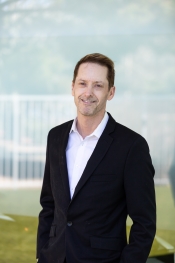When the COVID-19 virus rapidly spread in 2020, it is not an understatement to say that the world was unprepared for a pandemic.
According to Matthew Scotch — associate dean of research at Arizona State University’s College of Health Solutions — infrastructure issues, health inequities, poor international coordination and supply chains breakdowns were just a few of the contributing factors.
Scotch and a team of researchers from the Biodesign Institute have received a $6 million grant from the National Science Foundation (NSF) to ensure that we are globally prepared should there be another pandemic of the proportions of COVID-19.
The grant will fund the Environmental Surveillance Center for Assessing Pathogen Emergence, or ESCAPE. The center's goal is to develop tools for environmental surveillance, expand a global environmental surveillance network through community engagement and training, and promote environmental surveillance as a strategy for pandemic prevention.
ESCAPE has developed multiple strategies to tackle this challenge that are both inexpensive and easy to put in place. The three other institutions participating in the project include the Wildlife Conservation Society, the University of Kentucky and the University of Alaska Anchorage.
Scotch, who is also assistant director of the Biodesign Center for Environmental Health Engineering, and his team will be responsible for the "Data to Decisions" research area, which will support the translation of genomic data from environmental samples into information and knowledge for pandemic response and surveillance.
This includes working with community partners in Alaska, Arizona, Kentucky, Indonesia and Uganda.
ASU News spoke with Scotch about how the pandemic preparedness project can transform communities.
Note: Answers have been edited for length and/or clarity.
Question: How did you feel when you received the $6 million grant for this project?
Answer: We were beyond excited about it. It's a great group, and it's an important project. But most of all, we will be tackling a highly significant problem and getting the chance to do important science with some great scientists.
Q: What prompted the need for ESCAPE?
A: Historically, the U.S. and other countries have not been prepared for these things — and with infectious diseases, once you are behind, you are in big trouble.
I think the NSF was looking for more innovative ideas, more scientifically driven ideas and more collaborative efforts with communities where a lot of these things tend to happen, such as sub-Saharan Africa and Asia.
There's a big community science part of it too. It's not just finding a solution and then nothing ever happens. It's working with communities to test the validity of different approaches to monitoring and preventing infectious disease outbreaks. That includes working with communities to identify solutions to strengthen surveillance and preparedness.
Q: What was the biggest mistake made with the U.S. and global response to COVID-19?
A: There are a lot of lessons to be learned there. We were very much unprepared both locally and domestically, as well as internationally. We need to work together — to mobilize. That is where the real challenge is because with infectious disease the growth can be exponential.
Q: One of the goals of ESCAPE is to detect pathogens quickly. How will that work?
A: What we will be doing is monitoring environmental samples of wastewater from sewers, septic tanks, open trenches and even zoonotic pathogens, wildlife markets, hunter-harvested birds and animal die-offs. We will collect samples and use molecular testing and pathogen sequencing to understand its genetic code and any changes or mutations that might make it more dangerous or resistant to treatments. We will be monitoring that on a regular basis in certain communities we are partnering with around the world.
This approach has been shown to be advantageous in showing a signal before a signal is observed in clinical cases. Our testing philosophy is that what we can see in the wastewater, we can see in the population.
Q: What are some of the other challenges of putting this in place?
A: We're doing this at different sites, and we're testing for different pathogens. It’s not like one-size-fits-all. Every community is different in terms of resources, public health needs and pathogen diversity.
There's things you have to customize. There's community outreach that has to be done in specific languages. For example, we're going to Indonesia. We're going to Uganda. They're going to have different environmental surveillance infrastructure. So they're all going to have different setups. We need to understand the diversity of different pathogens and how that changes over time in different areas. That'll be a challenge for us.
Q: Will this help to make predictions about future outbreaks?
A: I don't know. I don't love the word “prediction.” I don't like to predict outbreaks because you just never know what's going to happen.
I like to take the information as real time to understand what we knew before and what we know now. And then use that as a guide to continuously monitor the situation and maybe to update the strategy, maybe to update priorities.
Q: How will your plan address the problem of global mobilization? How will you bring your solution to countries around the world?
A: We are not going to be able to set up surveillance systems in every possible place, right?
But this is a start. In our center, we use the phrase “environmental surveillance for everyone.” We want to show people — show communities — this type of framework with the idea that we want them to train the local communities on how to do this themselves and eventually have them training other people. And then you have the trainer model where, in the end, you're basically supporting the next generation of scientists to continue this going forward ... and then maybe that gets adopted in other locations.
So it's kind of like planting the seeds a little bit and then seeing how much they grow. But once we train them, we'll show that it's certainly feasible in terms of cost. The base technology is fairly cheap and can do a lot of powerful things, especially in terms of pathogen genomics.
Q: After the project is done, in seven years, what do you hope will come out of it?
A: Other than the fact that I will be a whole heck of a lot older than I was at the beginning, we will demonstrate that environmental surveillance is possible for everyone, irrespective of location and resources and can play a key role in pandemic monitoring and prevention.
So, basically, in seven years, we will have grown the network of locations that can perform routine and accurate environmental surveillance.
Q: With ESCAPE in place, how would a future response to a pandemic differ from the previous response?
A: Hopefully, what we'll show is that by expanding the network of environmental surveillance and doing that in communities that are historically underserved, we can improve our ability to identify and respond to emerging threats earlier.
Now, what happens after that? You know, it's hard to tell, but we can certainly support the idea of environmental surveillance for everyone.
That's sort of our catchline: environmental surveillance for everyone.
The research team includes senior investigators Arvind Varsani, Kerry Hamilton and Qiyun Zhu.
More Science and technology

Stuck at the airport and we love it #not
Airports don’t bring out the best in people.Ten years ago, Ashwin Rajadesingan was traveling and had that thought. Today, he is an assistant professor at the University of Texas at Austin, but back…

ASU in position to accelerate collaboration between space, semiconductor industries
More than 200 academic, business and government leaders in the space industry converged in Tempe March 19–20 for the third annual Arizona Space Summit, a statewide effort designed to elevate…

A spectacular celestial event: Nova explosion in Northern Crown constellation expected within 18 months
Within the next year to 18 months, stargazers around the world will witness a dazzling celestial event as a “new” star appears in the constellation Corona Borealis, also known as the Northern Crown.…



